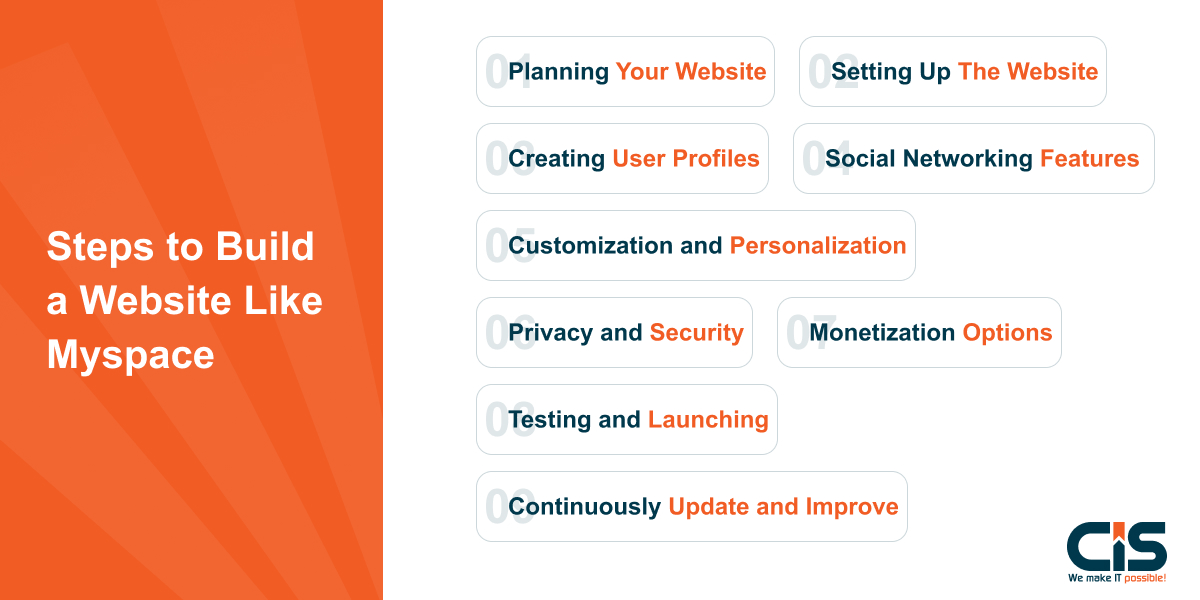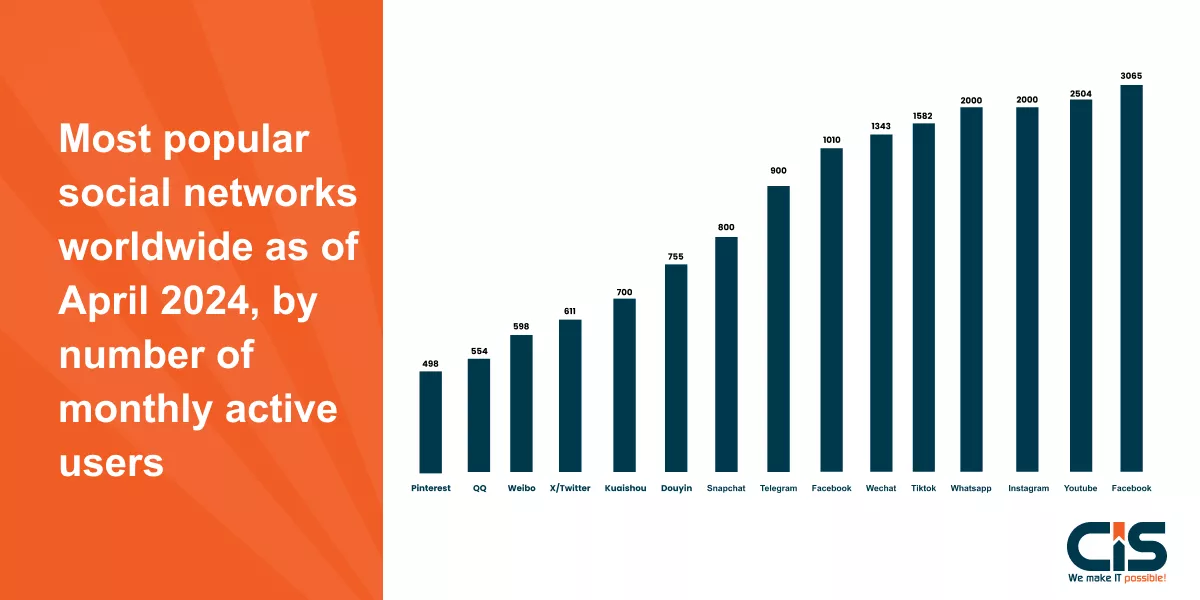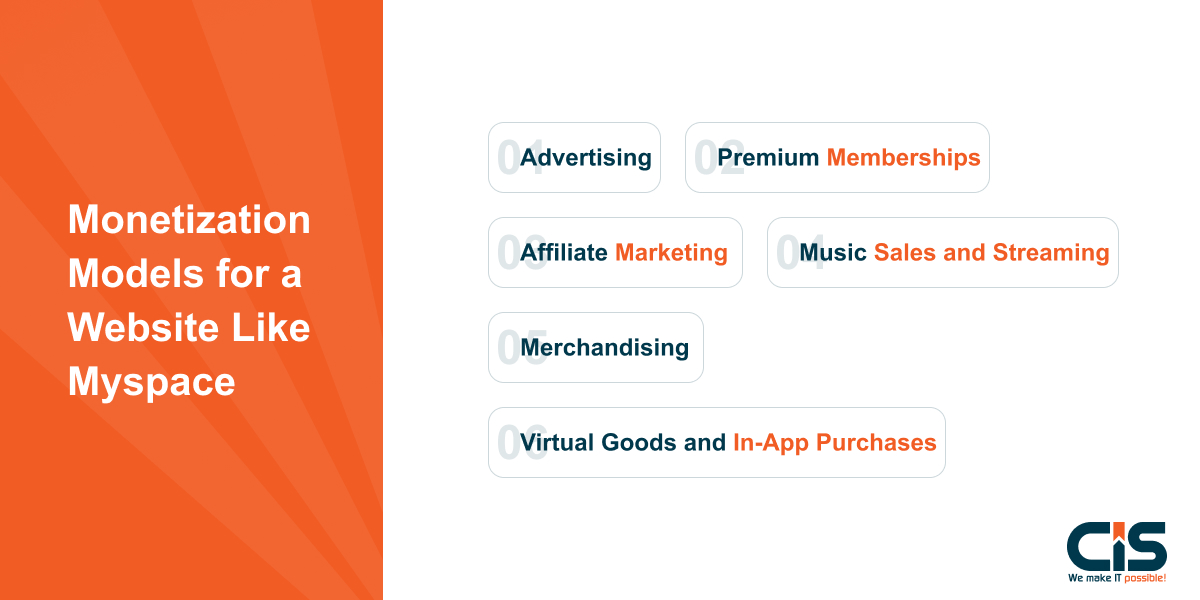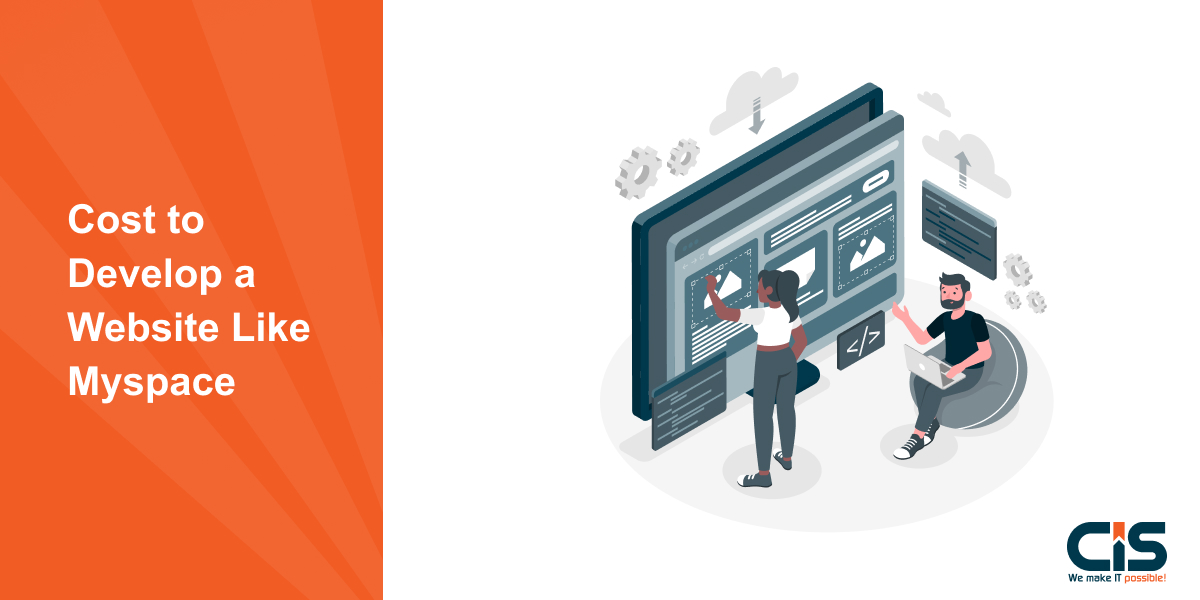Introduction
In the process of creating a website like Myspace the person can experience many opportunities and rewards, according to his/her desire to develop a social network site like Myspace. Myspace, one of the giants of the 2000s social network world, permitted its potential users to add friends, promote bands, change custom layouts, and other features. Today, the popularity of Myspace has considerably declined, yet it is still worthwhile to design an analogous website for the definite niche or consumers. This article will not only explain in detail how to get started and what steps need to be taken to create a social media website like Myspace, but it will also offer good advice.
Why Build A Website Like Myspace?
If you're considering why to build a website like Myspace and how to do it, our blog explores the key steps and strategies to create a successful online community.
- Niche targeting: This way, you can create a cross-site scripting that deals with a specific interest or group of people, and therefore, people will be provided with a social networking site to share their interests.
- Customization and personalization: Myspace was characterized by high flexibility in the customization of the profiles where people could be creative. Creating a social media website like Myspace provided the user the ability to customize the page and access to build an identity in online business - need advice that they would enjoy.
- Music sharing: Myspace was first found to be a site where musicians can provide their music. If you love music and wish to create a venue where musicians post their music, creating a Myspace-like site can be useful.
- Independence from mainstream social media: Some potential users appreciate specialized SNS because they are different from the open mainstream websites such as Facebook or Instagram. Thus, by building a Myspace-like website, you will be able to offer social media users to use as a replacement.
Steps To Build A Website Like Myspace

In 2024, social networking sites have over 4.7 billion potential users worldwide. Building a website like Myspace can tap into this massive audience.
I. Planning Your Website
Planning your website for building a social media platform like Myspace involves setting clear objectives, researching target demographics, defining core features, and designing a user-friendly interface.
- Define Your Target Audience
- Identify who will use your site (age, interests, location).
- Understand their needs and preferences.
- Identify Key Features and Functionalities to Include
- User base profiles
- Friend connections
- Messaging system
- Music and media sharing
- Customizable profiles
- Blogs and forums
- Sketch Out a Wireframe or Visual Layout of Your Website
- Create a simple layout with tools like Sketch, Figma, or Adobe XD.
- Outline main pages: homepage, user profiles, media gallery, etc.
- Ensure intuitive navigation and user-friendly design.
Read More: Social Media App Development: What's the Cost? How Much Can You Gain?
II. Setting Up the Website
- Choose a Domain Name and Hosting Platform
- Domain Name: Keep it short, memorable, and relevant to your brand.
- Hosting Platform: Popular options include Bluehost, SiteGround, and GoDaddy.
- Install a Content Management System (CMS) Like WordPress or Drupal
- WordPress: User-friendly, extensive plugin library, ideal for beginners.
- Drupal: Highly customizable, suitable for advanced users.
- Select a Suitable Theme or Template for Your Website
- Themes: Look for Myspace-inspired themes on social platforms like ThemeForest.
- Customization: Ensure the theme is easily customizable and mobile-responsive.
- Customize the Design and Layout to Match the Myspace Aesthetic
- Color Scheme: Use a dark, vibrant color palette similar to Myspace.
- Layout: Include customizable profile pages, music players, and friend lists.
- Widgets: Integrate social media widgets, blogs, and message boards.
III. Creating User Profiles
- Allow Users to Register and Create Profiles
- User Registration: Simplify the process to encourage sign-ups.
- Security: Implement strong password requirements and email verification.
- Social Login: Offer options to register using Google, Facebook, or Twitter accounts for convenience.
- Design a User-Friendly Registration Process
- Simple Forms: Minimize the number of fields required to register.
- Guidance: Provide tooltips and progress indicators to help users complete registration.
- Responsive Design: Ensure the registration form works well on all devices.
- Include Features Like Profile Pictures, Personal Information, and Status Updates
- Profile Pictures: Allow users to upload and crop images easily.
- Personal Information: Let users share details like bio, location, and interests.
- Status Updates: Enable users to post text updates, images, and links.
IV. Social Networking Features
- Incorporate friends/Follower System
-
Friends System:
- Users offer and accept friends.
- Friends are able to see the profiles and the latest updates of each other.
-
Followers System:
- People use other people's timelines just to see the posts of those they are not friends with.
- The given strategy may be helpful for public figures or rock-n-roll businesses.
Example: Also observe how Facebook's friend request system works and how the followers feature in twitter works. In the third quarter of 2023, Facebook reported around four billion monthly core Family product users.

- Enable Private Messaging Between Users
-
Direct Messaging:
- Users have a direct message option where they can communicate privately.
- No message is deleted, and even if it's deleted, all the messages are secured and seen only by the persons involved.
-
Group Messaging:
- Compiled says that users can easily create group chats for many people.
- Applicable in discourses and cooperation.
Screenshot: Present Facebook Messenger or Twitter Direct Messages instance
- Allow Users to Create and Join Groups or Communities
-
Group Creation:
- As to the types, there are two of them: public and private.
-
Joining Groups:
- It is easy for users to find and join groups of their interest.
- Allows people to find and associate with others who share similar opinions.
Infographic: Emphasize the advantages of interacting in groups on social network platform style.
V. Customization and Personalization
In today's digital landscape, the key to build a Myspace-like website lies in its seamless customization and personalized user experiences, offering a nostalgic yet modern platform for social interaction.
- Profile Customization
- Themes: Allow users to choose and apply themes.
- Layouts: Provide various layout options for unique styles.
- Backgrounds: Enable personalized custom background images or colors.
- Media Integration
- Music: Let users add songs to their band profiles.
- Videos: Allow video uploads and embedding from popular sites.
- Photos: Enable photo galleries and profile pictures.
- Playlists and Mixtapes
- Create Playlists: Allow users to compile and organize music.
- Share Playlists: Enable sharing playlists with friends.
- Mixtapes: Let users create and share mixtapes.
VI. Privacy and Security
- Implement Robust Data Protection Measures
- Encryption: Use SSL/TLS for data transmission.
- Data Storage: Use encryption to safely store private information.
- Access Controls: Implement role-based access controls (RBAC).
- Allow Users to Control the Privacy Settings of Their Profiles and Personal Information
- Profile Settings: Enable users to set profile creation visibility (public, friends only, private).
- Data Access: Allow users to download and delete their data.
- Consent Management: Obtain user consent for data collection and usage.
- Regularly Update and Maintain the Website's Security Features
- Software Updates: To fix vulnerabilities, update all software frequently.
- Security Audits: Perform penetration tests and security audits on a regular basis.
- Monitoring: Implement real-time monitoring for suspicious activities.
VII. Monetization Options
Exploring monetization options to develop a social media website like MySpace involves strategizing ad placements, integrating subscription services, offering premium user features, implementing affiliate marketing programs, and analyzing user data for targeted advertising.
- Explore Revenue Generation Methods
-
Advertising:
- Use Google search console AdSense to display ads and earn revenue based on clicks or impressions.
- Partner with brands for sponsored visual content or direct ad placements.
-
Premium Memberships:
- Offer exclusive basic features or content for a monthly or annual fee.
- Examples include ad-free experiences, advanced customization options, or access to special groups.
- Integrate E-commerce Features
-
Marketplace:
- Allow users to buy and sell products directly on your social platform.
- Use tools like Shopify or WooCommerce to set up a marketplace.
-
Affiliate Marketing:
- Get paid to promote other businesses' items and receive a commission on sales.
- Integrate affiliate links within your content for a seamless user experience.
VIII. Testing and Launching
- Conduct Thorough Testing of All Features and Functionalities
- Test User Interfaces: Check that the buttons, menus, and links are fully responsive
- Check Load Times: To ensure the amount of time spent navigating any page does not exceed three seconds, achieve the following.
- Verify Mobile Compatibility: Mobile traffic origin is more than half of all the traffic to the website.
- Security Testing: Guard against threats or virus attacks.
- Gather Feedback from Beta Users and Make Necessary Improvements
- Select Beta Users: It is very important to select a diverse set of Beta users.
- Collect Feedback: General self-administered questionnaires such as surveys, interviews, and feedback forms.
- Identify Common Issues: Target issues that are common with more than one user.
- Implement Improvements: This means that specific fixes and enhancements put in place should be prioritized based on the feedback.
- Launch the Website and Promote it Through Various Marketing Channels.
- Launch Announcement: Email blasts and press releases
- Social Media Promotion: The following social media platform design must be used: Facebook, Twitter, and instagram.
- SEO Optimization: Optimize your site for the search engines.
- Collaborate with Influencers: Go social and get the right influencers in your business analyst to extend your reach.
- Monitor Performance: Track the users' interaction and website performance by using tools such as Google Analytics.
IX. Continuously Update and Improve
- Regularly Update and Add New Features
- Stay Current: Keep up with the latest tech trends and integrate relevant basic features.
- User Engagement: Introduce interactive elements like polls, quizzes, and live chats.
- Fresh Content: Regularly post new articles, blogs, or updates to keep the content fresh.
- Monitor User Feedback and Respond to Their Needs
- Feedback Mechanisms: Implement surveys, feedback forms, and direct communication channels.
- Analyze Data: Use analytics tools to track user behavior and preferences.
- Act on Feedback: Make improvements based on user suggestions and complaints.
Monetization Models for a Website Like Myspace

In 2023, social media platforms advertising revenue was projected to reach $56 billion in the U.S. alone. Websites like Myspace have several opportunities to tap into this lucrative market.
Key Industry Statistics
- Social Media Ad Spend: Expected to grow by 15% annually.
- Digital Music Revenue: Estimated at $22 billion globally.
Monetization Models
-
Advertising
- Display Ads: Banner ads, pop-ups, and sidebar ads.
- Sponsored Content: Paid articles or posts from brands.
- Video Ads: Interstitial advertisements that occur before the commencement of the video, in the middle of the video play, and after its completion.
-
Premium Memberships
- Ad-Free Experience: Charge users for an ad-free interface.
- Exclusive Content: Offer premium content or features to paid members.
- Early Access: Provide early access to new features or music releases.
-
Affiliate Marketing
- Product Recommendations: Earn commissions by promoting products.
- Partner Programs: Collaborate with brands for affiliate links.
-
Music Sales and Streaming
- Digital Downloads: Sell individual tracks or albums.
- Subscription Services: Offer a monthly subscription for unlimited streaming.
- Concert Promotions: Promote and sell tickets for live events.
-
Merchandising
- Branded Merchandise: Sell branded clothing, accessories, and other items.
- Artist Merchandise: Partner with artists to sell their merchandise.
-
Virtual Goods and In-App Purchases
- Custom Skins and Themes: Sell customizations for user profiles.
- Virtual Gifts: Allow users to purchase and send virtual gifts to friends.
Cost To Develop A Website Like Myspace

Understanding the cost to develop a website like Myspace involves detailed analysis of design, functionality, development hours, and maintenance expenses, crucial for businesses aiming to replicate its social networking features. In 2024, the average cost to develop a social media platforms website ranges from $50,000 to $250,000.
Key Industry Statistics
- Social Media Users: Over 4.5 billion users globally.
- Development Time: Typically 3 to 12 months, depending on complexity.
Breakdown of Development Costs
-
Planning and Research
- Market analysis: $1,000 - $5,000
- Project requirements: $2,000 - $7,000
-
Design
- UI/UX design: $5,000 - $15,000
- Prototype development: $2,000 - $8,000
-
Front-End Development
- HTML/CSS/JavaScript: $10,000 - $30,000
- Responsive design: $5,000 - $10,000
-
Back-End Development
- Database setup: $8,000 - $20,000
- Server-side scripting: $15,000 - $50,000
-
Features and Functionality
- User profiles: $5,000 - $10,000
- Messaging system: $7,000 - $15,000
- News feed: $10,000 - $20,000
- Media uploads: $5,000 - $15,000
-
Testing and QA
- Manual testing: $5,000 - $15,000
- Automated testing: $10,000 - $20,000
-
Deployment and Maintenance
- Initial deployment: $3,000 - $7,000
- Ongoing maintenance: $2,000 - $10,000 per month
Additional Costs
-
Marketing and Launch
- Initial marketing: $10,000 - $30,000
- Ongoing promotions: $5,000 - $20,000 per month
-
Legal and Compliance
- Terms of service and privacy policy: $1,000 - $3,000
- Data protection compliance: $2,000 - $5,000
Conclusion
Consequently, the profile creation of a website like Myspace entails coordination, architectural and technical design provisions, and academic conception of a social network platform. By applying the guidelines presented in this article, one is in a position to develop a commodity whereby people are connected so that they can share and post items, feelings, and events they come across or experience.
Challenged, it is very important that one should identify the target group and the reason for having the website. This will assist when formulating the look and the aspects you are going to integrate. Then, select the specific platform style or content management system to use for a given app as well as its openness to allow rebalancing and reorientation of the recognized user experience. Do not neglect to have security measures for the users' data so that they feel secure in using the site.
Moreover, to increase the attractiveness and interaction level of the target audience you are welcome to provide such features as personal profiles, internal communication systems, and media galleries. Finally, repeatedly go through further changes and obtain feedback from the users for constant enhancement of the website.
Learning from mistakes and filling the void with dedication and creativity, as well as understanding all the factors that made Myspace so successful, you can create a website that would mirror the idea of social networking and offer its users a place on the Internet that they would love to be a part of.
If you are gearing up to step up in the challenge of creating your own Social Networking Site here at CISIN Web Solutions, we are ready to assist you. Being a professional development business analyst for years and having a strong team of professionals, we can explain to you all the steps and create the website of your dreams. So, do not hesitate to contact us as it is time to create your own Myspace-like website.




